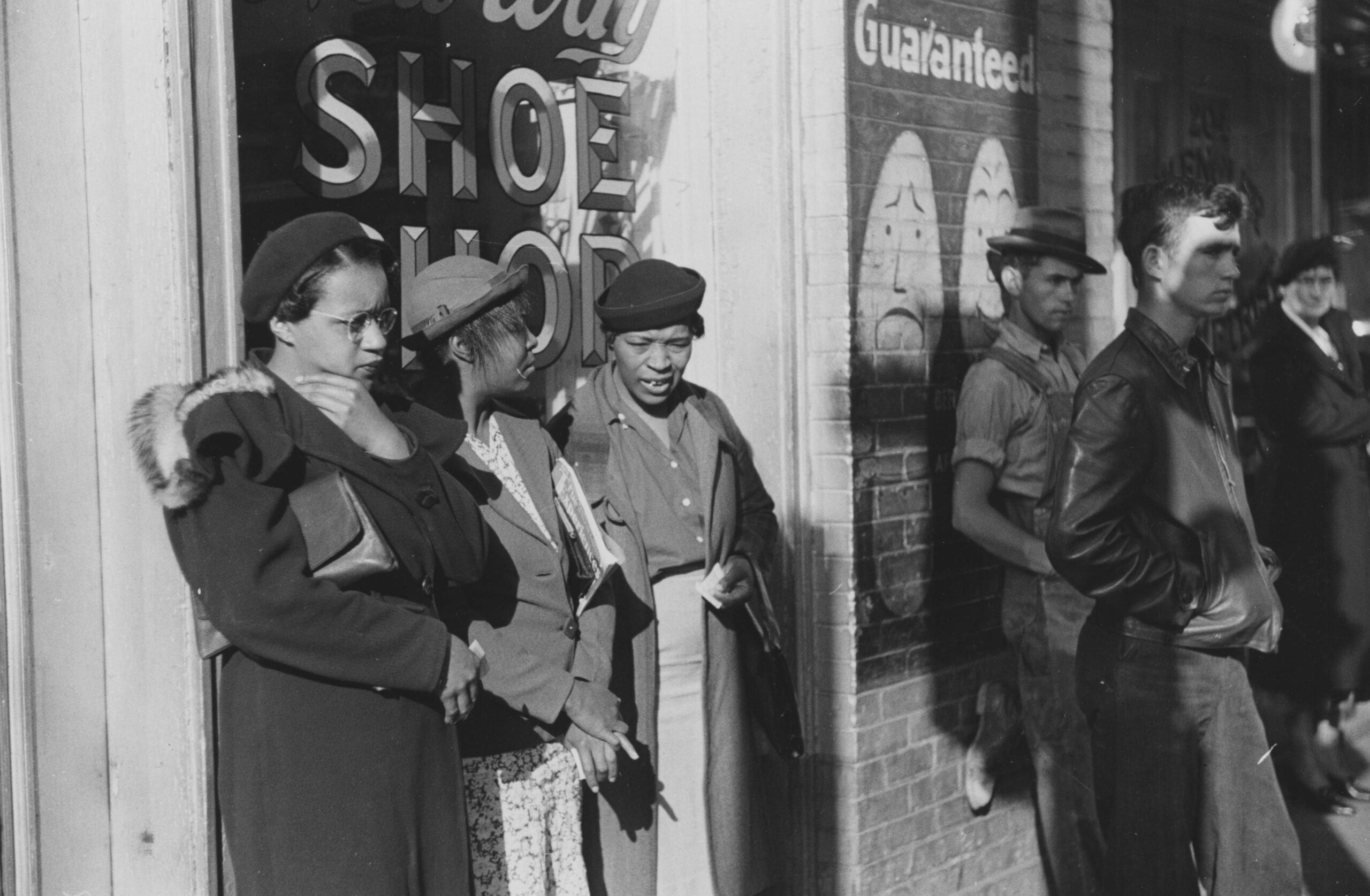Photo by Smith Collection/Gado/Getty Images
On a chilly morning in 1939, three Black women, bundled in jackets, hats, and fur collars, wait for the streetcar that will take them to their jobs as domestic workers. Two of the women turn towards each other, chatting and passing the time.
This photograph highlights the role of domestic labor in the lives of Black women in 1930s and 1940s Atlanta. Just as many Black women as men were in the workforce in Atlanta during this time, unlike their white counterparts. And while Black men would soon be able to find work in Atlanta’s diversifying wartime industry, Black women were still largely relegated to domestic labor in the homes of white Atlantans.
After taking the streetcar across town, these three Black women would have cleaned the houses, cooked the meals, and watched the children of white Atlanta families. They would have been closely supervised by their employers and been forced to show deference to them.
And for their labors, often taking more than 70 hours a week, they would have received a pittance for a wage. Domestic work for Black women was not just a bad job – it was a job that reinforced racial hierarchies and tied them to the history of slavery and a present of servitude.

While these three women are identified by the photographer as domestic workers, the photo also highlights the streetcar – which, perhaps moments after this photo was taken, screeched into view – and the role of public transportation in the lives of Black women in Atlanta.
Streetcars did not just take Black women to work. They were also spaces for socializing, commiseration, and organizing. Roughly thirty years after this photo was taken, in 1968, the first union for domestic workers, the National Domestic Workers Union (NDWU), was created in Atlanta by taking advantage of transportation as a site of Black women’s socializing.
Organizers, who had been domestic workers themselves, would get on the buses with women going to work and talk to them about the challenges they experienced while on the job – the long hours, the low pay, the lack of regular time off, and the disrespect they endured at work.
But these conversations weren’t just about work. Women also brought food to share and talked about the issues that shaped their lives. It is out of these conversations that an organization by and for domestic workers could come to fruition.
What these Black women organizers also understood is that buses connected Black women to their homes and their communities, not just to their jobs.

Photo by Bettmann Archive/Getty Images
In the early 1970s, when this photo was taken, Atlanta enjoyed a reputation as the “Black Mecca” because of its high rates of Black-owned businesses and Black home ownership. In 1974 Atlantans elected Maynard Jackson to be the city’s first Black mayor. The photographer called this image, “Contrast of Atlanta’s Slum and Skyline,” and it serves as a reminder that Mecca didn’t reach all Black Atlantans.
A Black woman gazes off into the distance toward downtown while children play around her on the scrap metal and detritus in the yard – one child has climbed onto a metal barrier, the other is rooting around among metal poles as a dog looks on with interest, and a third child crouches on a large wooden looking box thrown against some large metal barrels. As Black women went to work in the posh homes of Atlanta’s elite, they came home to the refuse of that glittering world strewn about their backyards.
This is also an image of a woman at home, leaning back slightly in her chair in slippers and an unstructured dress, watching children who are either hers, or children she knows, have fun. If the environment were different, perhaps with a picket fence and a perfect lawn, it would be easier to see this for the scene of domestic repose that it is – a woman and children enjoying the simple pleasure of being outside.
The domestic setting of the scene doesn’t negate the severe environmental, class, and race-based inequality depicted in the photo. However, if we want to understand how Black women became the backbone of Atlanta’s working-class activist organizations, we must understand both aspects of this image.
Working class Black women’s communities were not simply “slums,” they were communities with practices rooted in joy that organizers sought to protect. Black women did not just fight against the inequalities and violence they experienced. They also fought for an Atlanta that offered the infrastructure for all children to play safely outside, rather than in the garbage heap of urban growth and “progress.

Learn More:
Ferguson, Karen. Black Politics in New Deal Atlanta. Chapel Hill, NC: University of North Carolina Press, 2002.
Kelley, Robin D. G. “’We Are Not What We Seem’: Rethinking Black Working-Class Opposition in the Jim Crow South,” The Journal of American History 80, no. 1 (1993).
Hobson, Maurice J. The Legend of the Black Mecca: Politics and Class in the Making of Modern Atlanta (Chapel Hill: University of North Carolina Press, 2019).
Nadasen, Premilla. Household Workers Unite: The Untold Story of African American Women Who Built a Movement (Boston: Beacon Press, 2016).
Grady-Willis, Winston. Challenging U.S. Apartheid: Atlanta Black Struggles for Human Rights, 1960-1977. Durham: Duke University Press, 2006.
Hunter, Tera. To ‘Joy My Freedom: Southern Black Women’s Lives and Labors After the Civil War. (Cambridge, Mass.: Harvard University Press, 1998).





